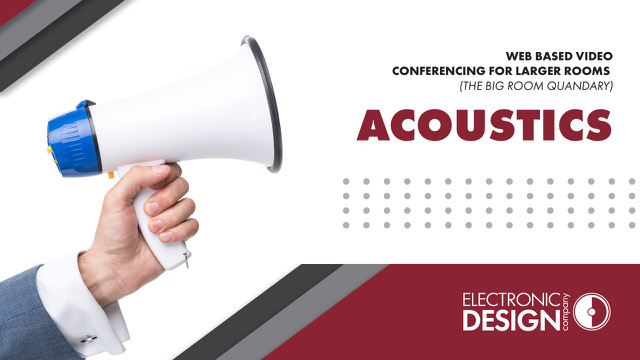
Web Based Video Conferencing for Larger Rooms (The Big Room Quandary): Acoustics
August 18, 2021Most of us listen to some sort of media in our vehicle. It could be broadcast radio, your favorite Podcast, or your own mix of eclectic music. As you start driving down your neighborhood street, you are listening at a fairly, moderate level but as you enter the highway toward your destination, you notice you are not able to make out what is being said anymore so you turn up the volume. As you get to your destination, you slow down and now it to seems too loud. As the ambient noise level goes up, intelligibility goes down. To compensate, you turn the source level up. This audio phenomenon is called masking. In the world of conferencing, it is unwanted sounds or noise getting picked up by the microphone. Short of, “your mic isn’t on,” it is the number one reason that the far end has difficulty understanding what is being said from the near end. HVAC noise, people talking in the hallway, rain on the roof, nearby road traffic, and papers rustling on the conference room table are some of the obvious ambient noises that contribute to masking.
One contributor to masking that is not as obvious is room acoustics. Hard surfaces can create reflections that can be picked up by the microphones being used to send audio to the far end of a conference. When sound bounces off surfaces, it creates multiple sound paths back into the microphone at different times. This “reverberation” of the sound in the room being picked up by the microphones will mask the direct sound from the presenter. Large rooms create much longer reverberation times. This can increase not only the level, but the duration of unwanted sound into the microphone and decreases intelligibility.
How do we deal with the challenges of adverse room acoustics? Nobody likes to hear this answer, but it depends. The objective is to get the direct sound from the presenter louder than the indirect sound or reverberation of the room. The easiest way to do this is to move the microphone closer to the presenter. When this is not feasible or aesthetically pleasing, it becomes necessary to find the room’s “critical distance” to determine how far away a microphone can be from the source before picking up too much reverberation of the room. In very reflective and larger rooms, the critical distance may be shorter than where you can physically locate a microphone to pick up people talking. To increase this distance, one could treat the room surfaces with absorbing or diffusing materials to create a room that is better acoustically behaved. There is math and modeling involved to do this correctly. This approach, most of the time, is dealt with when a room is being constructed and has the potential to come with a large price tag to do it in such a matter as to not ruin the aesthetics of the room. The bottom line, every room is unique. It becomes a team effort combined with experience and knowledge of technological options to determine what can be done to provide the best conferencing experience for each space.
NEXT INSTALLMENT: System cabling requirements for larger rooms.


